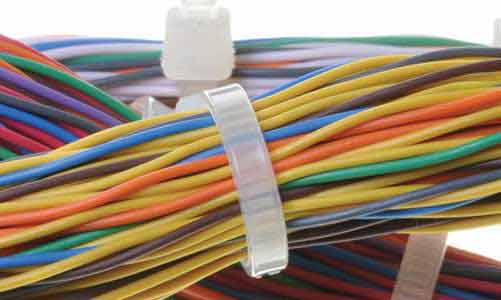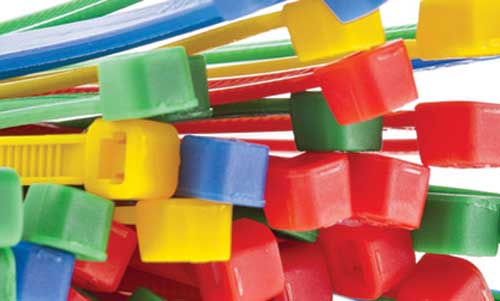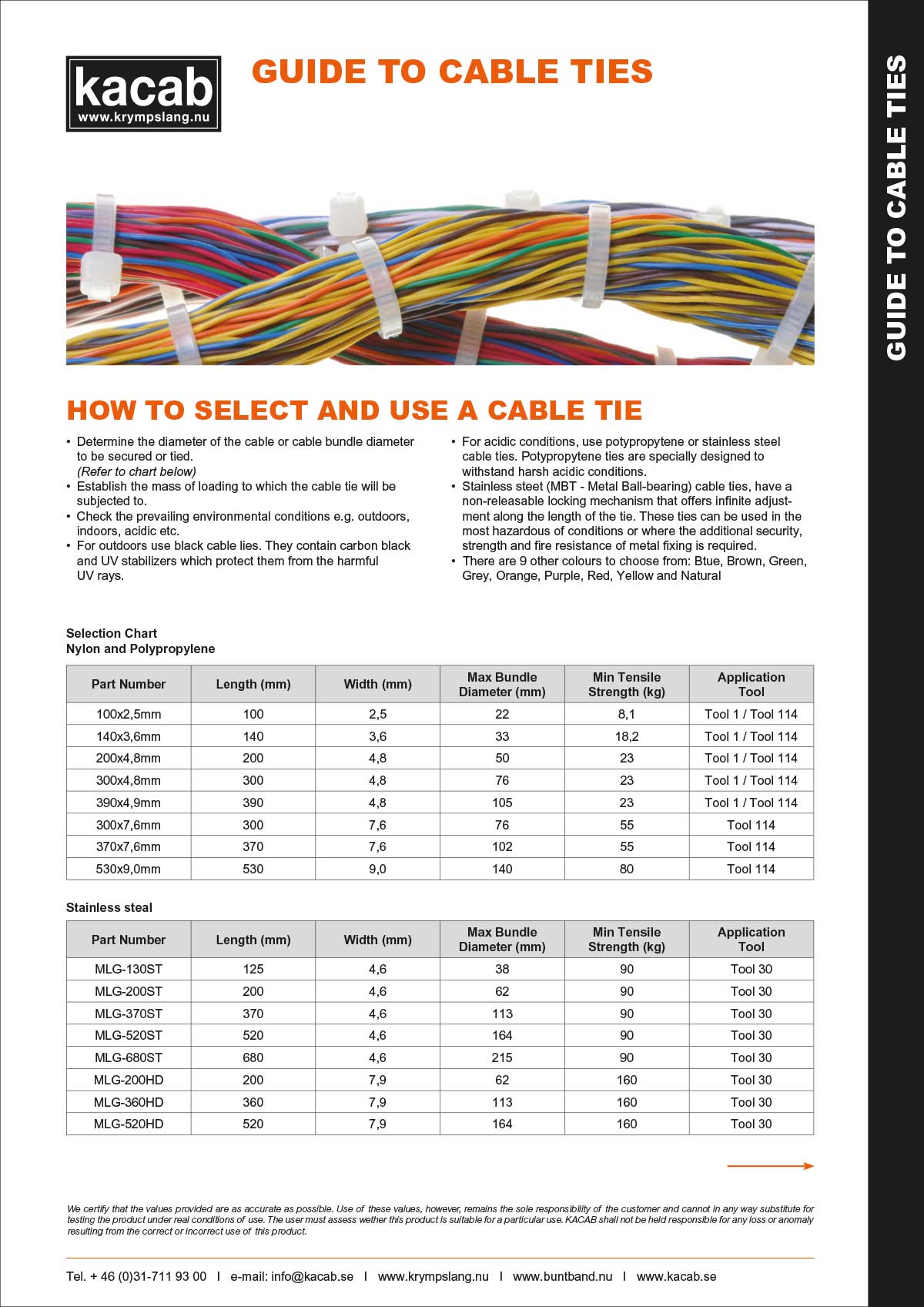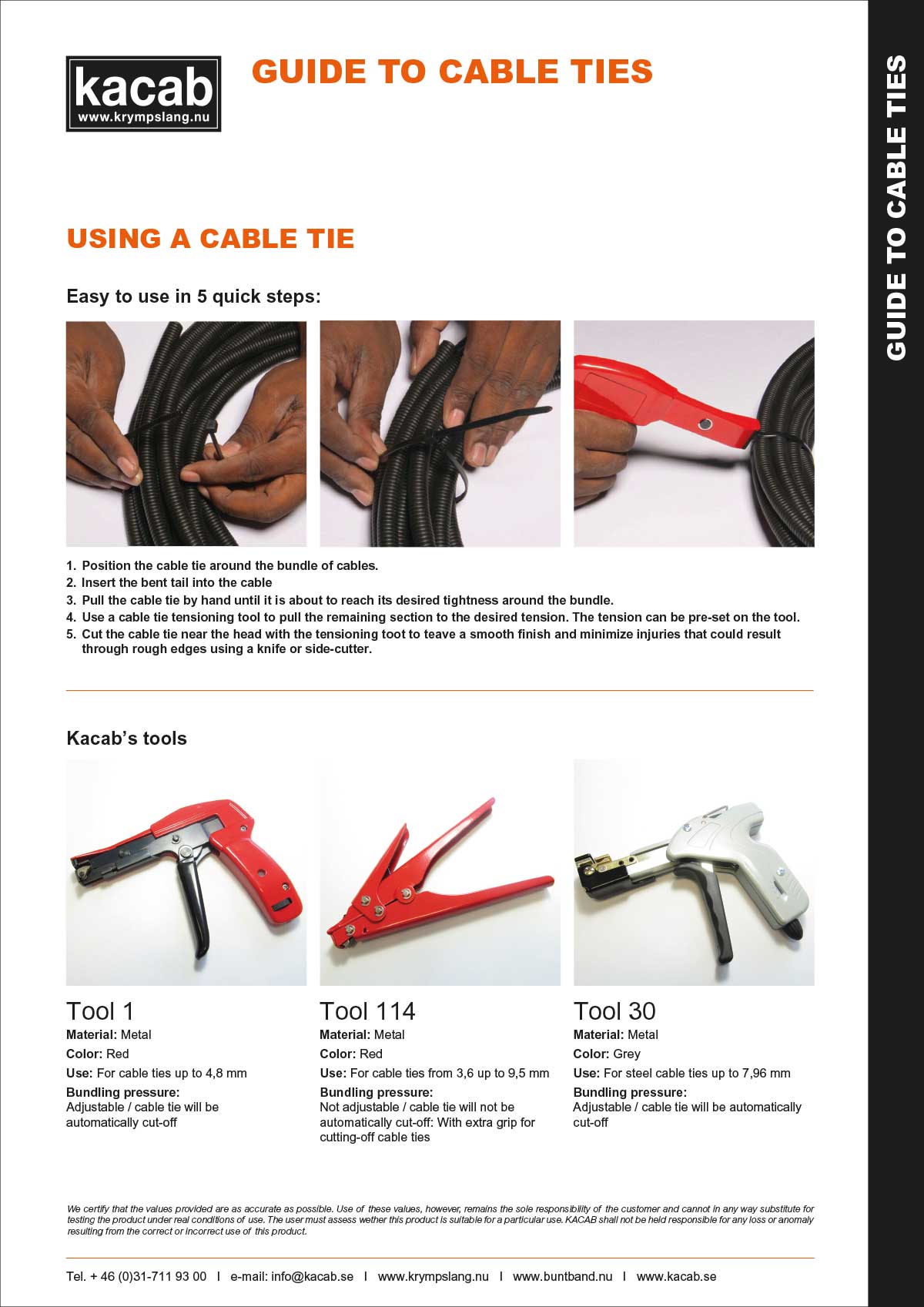Cable Tie-Guide – Choose the right cable tie!

How to choose the right cable ties with our Cable Ties Guide
Cable ties guide – Cable ties are very useful in many different contexts where you want to attach, hold together or close something. There are also a variety of different types and materials of cable ties that are suitable for different purposes.
För att välja rätt buntband för rätt applikation är det några saker man bör beakta, gör det med vår buntbands-guide.
For example, choose black cable ties when using them outdoors. Dessa band är UV-stabiliserade och står emot solens inverkan betydligt bättre än naturella band.
Om man vill använda banden i miljöer där det förekommer andra faktorer som t ex höga temperaturer, föroreningar, kemikalier etc. kan man med fördel välja ett band i ett annat material. Examples of this can be Polypropylene, Tefzel, Stainless steel etc.
When choosing a cable tie, you should ask yourself the following questions:
Length How far must the band be to reach around what I want to bundle together?
Strength Is any special tensile strength required on the belt? Should it hold something heavy?
Environment Should the cable tie be in a particularly exposed environment? Utomhus (UV-strålar) eller kommer det vara utsatt för kemikalier
Temperatur Vilken omgivningstemperatur är det på platsen bandet skall sitta?
This is how we handle cable ties according to our Cable Ties guide
The quality of a cable tie therefore depends on a number of surrounding factors. In part, the most commonly used material is Polyamide 66 (PA66) hygroscopically, which means that it absorbs and releases water. This in turn means that the cable tie is differently flexible at different water contents. In order to always have as good a cable tie as possible, it is important to store these in a suitable way. It is especially important not to leave an opened bag for a long time without using the straps. In addition, there is the risk that the water will disappear out of the bands and they can be perceived as more inflexible. This is especially true during the cold season.
Några förvaringstips!
Förvara alltid buntbanden i en försluten plastpåse.
Utsätt inte banden för direkt solljus.
Slutligen låt inte banden ligga för nära direkta värmekällor (element).
Cable Tie-Guide – Choose the right cable tie!

How to choose the right cable ties with our Cable Ties Guide
Cable ties guide – Cable ties are very useful in many different contexts where you want to attach, hold together or close something. There are also a variety of different types and materials of cable ties that are suitable for different purposes.
To choose the right cable tie for the right application, there are a few things to consider. Do so with our cable tie guide.
For example, you should choose black cable ties when using them outdoors. These bands are UV-stabilized and resist the effects of the sun significantly better than natural bands.
If you want to use the belts in environments where other factors occur such as high temperatures, pollution, chemicals, etc., you can advantageously choose a belt made of a different material. Examples of this can be Polypropylene, Tefzel, Stainless steel etc.
When choosing a cable tie, you should ask yourself the following questions:
Length How far must the band be to reach around what I want to bundle together?
Strength Is any special tensile strength required on the belt? Should it hold something heavy?
Environment Should the cable tie be in a particularly exposed environment? Utomhus (UV-strålar) eller kommer det vara utsatt för kemikalier
Temperatur Vilken omgivningstemperatur är det på platsen bandet skall sitta?
This is how we handle cable ties according to our Cable Ties guide
The quality of a cable tie therefore depends on a number of surrounding factors. In part, the most commonly used material is Polyamide 66 (PA66) hygroscopically, which means that it absorbs and releases water. This in turn means that the cable tie is differently flexible at different water contents. In order to always have as good a cable tie as possible, it is important to store these in a suitable way. It is especially important not to leave an opened bag for a long time without using the straps. In addition, there is the risk that the water will disappear out of the bands and they can be perceived as more inflexible. This is especially true during the cold season.
Några förvaringstips!
Förvara alltid buntbanden i en försluten plastpåse.
Utsätt inte banden för direkt solljus.
Slutligen låt inte banden ligga för nära direkta värmekällor (element).
Cable ties for the industry
From standard cable ties to advanced fastening solutions
Cable ties must meet a wide range of requirements, as they are used in many different uses – from simple bundling of cables with cable ties for very specific use of cable ties in extreme conditions.
Kacab Teknik AB offers a comprehensive portfolio of fastening solutions for all industrial requirements:
Resealable cable ties for temporary fastening, colored cable ties for color coding, fasteners for cable ties for attachment to plates, welding bolts, panel edges or cable ties in stainless steel for demanding conditions.
Available Cable Ties at KACAB:
In several different sizes, in different colors, made of 100% high quality plastic easily applied by hand or with a process tool.
Special cable ties offered include:
Weather-resistant and impact-resistant cable ties
Buntband för höga temperaturer
Buntband med låg brandrisk Öppningsbara eller frigörbara buntband
Buntband för parallell kabeldragning

Cable ties for the industry
From standard cable ties to advanced fastening solutions
Cable ties must meet a wide range of requirements, as they are used in many different uses – from simple bundling of cables with cable ties for very specific use of cable ties in extreme conditions.
Kacab Teknik AB offers a comprehensive portfolio of fastening solutions for all industrial requirements:
Resealable cable ties for temporary fastening, colored cable ties for color coding, fasteners for cable ties for attachment to plates, welding bolts, panel edges or cable ties in stainless steel for demanding conditions.
Available Cable Ties at KACAB:
In several different sizes, in different colors, made of 100% high quality plastic easily applied by hand or with a process tool.
Special cable ties offered include:
Weather-resistant and impact-resistant cable ties
Buntband för höga temperaturer
Buntband med låg brandrisk Öppningsbara eller frigörbara buntband
Buntband för parallell kabeldragning
Selected products:
Detactable cable ties
Detectable cable ties were thus developed especially for use in the food, beverage and pharmaceutical industries. It is ideal for installing wiring in and around open production lines.
Detactable cable ties are made in a unique process that involves the addition of metal particles in the plastic granules This makes it possible to detect even small, cut-off parts of the cable tie with commercially available metal detectors.
These cable ties can also be used to help meet HACCP requirements. The color of the cable ties supports visual recognition, which further reduces the risk of contamination.
Different cable tie colors for individual applications
The classic black cable ties still the most popular cable tie. But KACAB also offers its customers awide range of cable ties in different colors – including red, green, brown, white and transparent.
These cable ties are ideal for color coding/marking: for example, installers can be helped to find certain parts faster or assign them correctly. This consequently plays an important role in the automotive industry, but also in several other industries.
Certain industries prefer a certain color for cable ties: In the food industry, for example, blue is often used, while red plays an important role in the aviation sector.
This is one of the reasons why KACAB offers a particularly wide range of cable tie solutions in different colors.
Metal cable ties for demanding environments
Stålbuntband rekommenderas för användningsområden som exempelvis kräver extrem draghållfasthet eller extrema materiella krav under svåra förhållanden. De garanterar maximal säkerhet och brandbeständighet under de särskilt svåraste nödfallen.
It is often necessary to also use metal cable ties where chemicals are used. High-quality acid-resistant stainless steel protects against corrosion. As a result, stainless steel cable ties can often be found on ships, in tunnels, mines and even in the petrochemical industry.
Coated cable ties to prevent contact corrosion
Metal cable ties with polyester coatingin SS316 (V4A) stainless steel have the same advantages as ordinary steel cable ties, but thanks to the coating, they guarantee improved installation comfort at low temperatures.
In addition, the plastic coating is particularly suitable for sensitive cable bundles and to prevent contact corrosion.
KACAB Teknik AB is now the general agent for ITW-ELEMATIC in Sweden – Our Cable Ties Guide
We are proud to announce that KACAB now has the general agency for ITW-Elematic in Sweden. Among other things, we will sell their world-famous cable ties 2-Lock. However, we will, among other things, sell their world-famous cable ties 2-Lock.
FAQ
What is a cable tie?
Ett buntband, följaktligen även känt som straps eller strips, är en typ av fästelement som är speciellt tillverkat för att bunta ihop eller märka upp / organisera flera kablar, ledning eller slangar.
Where is cable ties used?
Buntband och fästelement för buntband används inom många branscher och installationer, exempelvis:
Electrical installations
Cabinet construction
The construction industry for preliminary installation purposes
The packaging industry
Extreme environmental conditions in, for example, the offshore industry
What type of cable ties should one choose?
Mainly in the assortment there are cable ties in different materials, for example plastic or metal, depending on the area of use. Different colors such as black, red, blue, white, etc. that make it easier to mark and distinguish different cables thanks to the uniquecolor markings. Maybe your cable ties will be exposed to extreme weather conditions? Then we also have cable ties that can handle everything from high plus degrees to very low minus degrees.
The use of a cable tie is large, and the choice of material can be decisive for your application. Maybe you are looking for a cable tie with extreme tensile strength? Then it is a cable tie with stainless steel straps in combination with ball locking that may be the right combination for your area of use. The variations and areas of use for cable ties are many, among others are used detectable cable ties with metal content for the food industry.
In the automotive industry, for example, double-bundle straps are used for parallel pulling, especially soft straps with Velcro fastening to protect the cables. Regardless of which industry or application, we have the cable tie for you Whether you are looking for rotatable cable ties that can be rotated 360 degrees, cable ties with fiberglass reinforced locking pins or fasteners in different colors and materials, we have something to suit you!
Polyamide 66, what is it?
Polyamide is one of the most important synthetic thermoplastic materials. Thermoplastic can be formed by heat as often as required without having to undergo chemical decomposition or other adverse changes. With this in mind, polyamide is ideal for processing via plastic injection molding into high-quality products.
Approximately 90% of all cable ties and fasteners from KACAB are made of this material. Polyamide is also known under the brand name Nylon®, which was introduced by the company Dupont in 1937.
Polyamid PA66 har många egenskaper som är fördelaktiga för HellermannTytons buntband och fästanordningar, såsom:
Styvhet, hårdhet och Hög styrka
Högdimensionell stabilitet, även under inverkan av värme
Hög slitstyrka
A wide range of polyamides and additives consequently makes it possible to optimally adapt the properties of the final product to meet the respective requirements.
What is the minimum tensile strength of a cable tie?
The minimum tensile strength is also an important parameter when choosing cable ties. It expresses how much load one cable ties can withstand. The minimum tensile strength of a cable tie is determined in accordance with military specifications and US standards. Testresultatet i MIL-S-23190E inkluderar:
Konditionering av buntbandens testdelar
Konstruktion av testutrustning
Applicering av ett buntband på testjiggen
Testhastighet
How do I store cable ties correctly?
Do not expose cable ties to direct sunlight. Do not therefore store cable ties in sunlight, e.g. on the windowsill.
Always store cable ties in the sealed plastic bag made of polyethylene. Once the bag is opened, use the cable ties as quickly as possible to ensure optimal application results. If the straps become brittle, they may break during use
Do not store cable ties near direct heat sources. Also avoid contact with heat: e.g. do not place on elements.
The ideal storage conditions for cable ties are, in short, Central European standard climate.
Whereas for optimal handling of cable ties, in other words, it is important that the material is in an equilibrium condition with a water content of approx. 2.5%.
FAQ
What is a cable tie?
Ett buntband, följaktligen även känt som straps eller strips, är en typ av fästelement som är speciellt tillverkat för att bunta ihop eller märka upp / organisera flera kablar, ledning eller slangar.
Where is cable ties used?
Buntband och fästelement för buntband används inom många branscher och installationer, exempelvis:
Electrical installations
Cabinet construction
The construction industry for preliminary installation purposes
The packaging industry
Extreme environmental conditions in, for example, the offshore industry
What type of cable ties should one choose?
Mainly in the assortment there are cable ties in different materials, for example plastic or metal, depending on the area of use. Different colors such as black, red, blue, white, etc. that make it easier to mark and distinguish different cables thanks to the uniquecolor markings. Maybe your cable ties will be exposed to extreme weather conditions? Then we also have cable ties that can handle everything from high plus degrees to very low minus degrees.
The use of a cable tie is large, and the choice of material can be decisive for your application. Maybe you are looking for a cable tie with extreme tensile strength? Then it is a cable tie with stainless steel straps in combination with ball locking that may be the right combination for your area of use. The variations and areas of use for cable ties are many, among others are used detectable cable ties with metal content for the food industry.
In the automotive industry, for example, double-bundle straps are used for parallel pulling, especially soft straps with Velcro fastening to protect the cables. Regardless of which industry or application, we have the cable tie for you Whether you are looking for rotatable cable ties that can be rotated 360 degrees, cable ties with fiberglass reinforced locking pins or fasteners in different colors and materials, we have something to suit you!
Polyamide 66, what is it?
Polyamide is one of the most important synthetic thermoplastic materials. Thermoplastic can be formed by heat as often as required without having to undergo chemical decomposition or other adverse changes. With this in mind, polyamide is ideal for processing via plastic injection molding into high-quality products.
Approximately 90% of all cable ties and fasteners from KACAB are made of this material. Polyamide is also known under the brand name Nylon®, which was introduced by the company Dupont in 1937.
Polyamid PA66 har många egenskaper som är fördelaktiga för HellermannTytons buntband och fästanordningar, såsom:
Styvhet, hårdhet och Hög styrka
Högdimensionell stabilitet, även under inverkan av värme
Hög slitstyrka
A wide range of polyamides and additives consequently makes it possible to optimally adapt the properties of the final product to meet the respective requirements.
What is the minimum tensile strength of a cable tie?
The minimum tensile strength is also an important parameter when choosing cable ties. It expresses how much load one cable ties can withstand. The minimum tensile strength of a cable tie is determined in accordance with military specifications and US standards. Testresultatet i MIL-S-23190E inkluderar:
Konditionering av buntbandens testdelar
Konstruktion av testutrustning
Applicering av ett buntband på testjiggen
Testhastighet
How do I store cable ties correctly?
Do not expose cable ties to direct sunlight. Do not therefore store cable ties in sunlight, e.g. on the windowsill.
Always store cable ties in the sealed plastic bag made of polyethylene. Once the bag is opened, use the cable ties as quickly as possible to ensure optimal application results. If the straps become brittle, they may break during use
Do not store cable ties near direct heat sources. Also avoid contact with heat: e.g. do not place on elements.
The ideal storage conditions for cable ties are, in short, Central European standard climate.
Whereas for optimal handling of cable ties, in other words, it is important that the material is in an equilibrium condition with a water content of approx. 2.5%.



